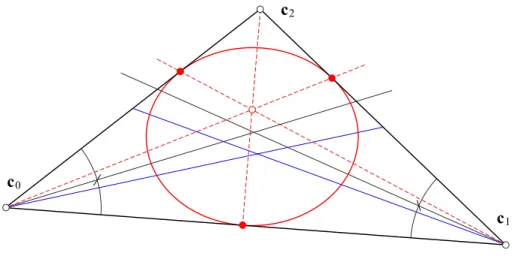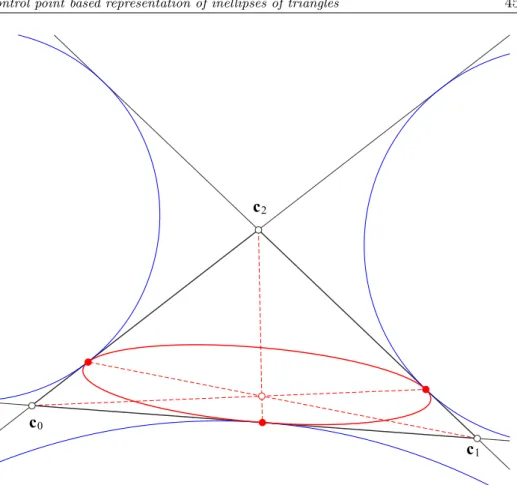Control point based representation of inellipses of triangles ∗
Imre Juhász
Department of Descriptive Geometry, University of Miskolc, Hungary agtji@uni-miskolc.hu
Submitted April 12, 2012 — Accepted May 20, 2012
Abstract
We provide a control point based parametric description of inellipses of triangles, where the control points are the vertices of the triangle themselves.
We also show, how to convert remarkable inellipses defined by their Brianchon point to control point based description.
Keywords: inellipse, cyclic basis, rational trigonometric curve, Brianchon point
MSC: 65D17, 68U07
1. Introduction
It is well known from elementary projective geometry that there is a two-parameter family of ellipses that are within a given non-degenerate triangle and touch its three sides. Such ellipses can easily be constructed in the traditional way (by means of ruler and compasses), or their implicit equation can be determined. We provide a method using which one can determine the parametric form of these ellipses in a fairly simple way.
Nowadays, in Computer Aided Geometric Design (CAGD) curves are repre- sented mainly in the form
g(u) =Pn
j=0Fj(u)dj
Fj: [a, b]→R, u∈[a, b]⊂R, dj∈Rδ, δ≥2
∗This research was carried out as a part of the TAMOP-4.2.1.B-10/2/KONV-2010-0001 project with support by the European Union, co-financed by the European Social Fund.
http://ami.ektf.hu
37
where dj are called control points andFj(u) are blending functions. (The most well-known blending functions are Bernstein polynomials and normalized B-spline basis functions, cf. [4].)
2. Cyclic curves and their rational extension
In [7] a new set of blending functions - called cyclic basis - have been introduced that are suitable for the description of closed trigonometric curves (the coordinate functions of which are trigonometric polynomials). The cyclic basis of the vector space
Vn=h1,cos(u),sin(u), . . . ,cos(nu),sin(nu)i of trigonometric polynomials of degree at mostn≥1 is
Ci,n(u) = cn
2n
1 + cos
u+i 2π 2n+ 1
n
:u∈[−π, π]
2n
i=0
, (2.1) where constant
cn= 22n (2n+ 1) 2nn fulfills the recursion c1= 23,
cn= 2n+12n cn−1, n≥2.
Observe, that basis (2.1) consists of 2π-periodic functions, thus we can study the properties of this basis and the corresponding curve on any interval of length2π.
By means of these basis functions we can specify cyclic curves in the following way.
Definition 2.1. The curve a(u) =
X2n i=0
Ci,n(u)di, u∈[−π, π], (2.2) is called cyclic curve of degree n ≥1 that is uniquely determined by its control pointsdi ∈Rδ,(δ≥2) and basis functions (2.1).
Cyclic curves have the following advantageous properties:
• singularity free parametrization (the curve is ofC∞ continuity at all regular points and at singular points non-vanishing left and right derivatives exist);
• convex hull property;
• cyclic symmetry (the shape of the curve does not change when its control points are cyclically permuted);
• closure for the affine transformation of their control points;
• pseudo local controllability;
• variation diminishing.
A simple exact formula has also been provided in [8] for the conversion from the traditional trigonometric representation to the control points based cyclic one.
This facilitates the exact control point based description of several remarkable closed curves, such as epi- and hypocycloids, Lissajous curves, torus knots and foliums.
Associating weights with control points of curve (2.2) we can describe closed rational trigonometric polynomial curves in the form
g(u) = X2n i=0
diRi,n(u)
Ri,n(u) = wiCi,n(u) X2n
j=0
wjCj,n(u)
, u∈[−π, π] (2.3)
where 0 ≤wi ∈ R,P2n
i=0wi6= 0
are the associated weights (cf. [5]). When all weights are equal, we obtain the cyclic curve (2.2) as a special case.
Curve (2.3) can also be considered as the central projection of the curve gw(u) =
X2n i=0
Ci,n(u) widi
wi
, u∈[−π, π]
in theδ+ 1dimensional space from the origin on to the δdimensional hyperplane w= 1(assuming that the last coordinate of space Rδ+1 is denoted by w). Curve gw is called the pre-image of curve g. This central projection concept facilitates to study the properties of curve g. Curve g inherits all properties ofgw that are invariant under central projection, such as continuity, incidence, colinearity and variation diminishing. Curve (2.3) is closed for the projective transformation of its control points, i.e. the curve determined by the transformed control points coincides with the transformed curve. The transformation has to be performed in the pre-image space, therefore not only control points but weights will also be altered.
3. Inellipses of a triangle
Inellipses of a non-degenerate triangle can be constructed by applying the theorem of Brianchon (cf. [2]). The implicit representation of them can also be determined cf. [9]. We provide a control point based parametric representation of inellipses, by means of rational trigonometric curves (2.3).
In [7] the following theorem has been proved.
Theorem 3.1. If n= 1 the curve (2.2) is the ellipse that touches the sides of the control triangle at its midpoints, and the centre of the ellipse is the centroid of the triangle, i.e. the ellipse is the Steiner inellipse of the control triangle.
In order to describe all inellipses of a triangle, we consider the case n = 1 of the rational extension of cyclic curves. Let us denote the position vectors of the vertices of the given triangle byc0,c1andc2. The rational trigonometric curve of degree one, determined by these points (as control points) is
g(u) =P2
i=0Ri,1(u)ci, u∈[−π, π], wi >0 Ri,1(u) = wiCi,n(u)
P2
j=0wjCj,n(u) Ci,1(u) = 1
3
1 + cos
u+2πi 3
(3.1)
Weights are determined up to a non-zero scaling factor, i.e. weights wi and λwi, 0 < λ ∈ R specify the same curve, therefore we can assume without the loss of generality that w0 = 1. Curve (3.1) is also an ellipse, since it is a central projection of an ellipse that does not intersect the vanishing plane if the weights are non-negative (cf. Fig. 1).
Figure 1: The inscribed ellipse (blue) and its pre-image (red).
Substitutingπ, π/3 and−π/3 intoRi,1(u)we obtain the values R0,1(u) R1,1(u) R2,1(u)
π 0 ww1
1+w2 1−w1w+w1 2
π/3 1+w1
2 0 1−1+w1 2
−π/3 1+w1
1 1−1+w1 1 0
which means that the ellipse touches the sides of the control triangle at its
points
m2=1+w1
1c0+
1−1+w1 1
c1, m0=ww1
1+w2c1+
1−w1w+w1 2
c2, m1=1+w1
2c0+
1−1+w1 2
c2.
(3.2)
Thus, the curve
g(u) = c0C0,1(u) +w1c1C1,1(u) +w2c2C2,1(u)
C0,1(u) +w1C1,1(u) +w2C2,1(u) (3.3) is the parametric representation of the two-parameter (w1, w2∈R) family of inel- lipses of the triangle with verticesc0,c1,c2, and the points of contact are determined by equalities (3.2).
Two points of contact can arbitrarily be chosen on the sides, from which weights can be determined that uniquely specifies the corresponding inellipse. Let us as- sume that points of contact m0 and m1 are specified on the sidesc1c2 andc0c2, respectively. Point m0 can be written as a barycentric combination of points c1
andc2in the form
m0=αc1+ (1−α)c2, α∈(0,1) analogously
m1=βc0+ (1−β)c2, β ∈(0,1)
Since, the barycentric combination of points of straight line segments with respect to the endpoints is unique, we have the equalities
α= w1
w1+w2,β= 1 1 +w2
from which we obtain the weights w2=1−β
β ,w1= α(1−β) β(1−α) that are needed for the representation (3.3).
There are several remarkable inellipses of triangles, a collection can be found at [9]. These are often specified by the trilinear coordinates of their Brianchon point.
The Brianchon point of an inellipse of a triangle is the common point of those lines that join point of contacts with the opposite vertices of the triangle, cf. Fig. 2.
Trilinear coordinates (α, β, γ) of a pointpwith respect to a reference triangle are an ordered triplet of numbers, each of which is proportional to the directed distance fromp to one of the sides (cf. [10]). The relation between the directed distances and the trilinear coordinates is
a1=kα,b1=kβ,c1=kγ
k= 2∆
aα+bβ+cγ, (3.4)
Figure 2: Trilinear coordinates.
wherea, b, cdenotes the length of the sides,a1, b1, c1are the corresponding directed distances (cf. Fig. 2) and∆is the area of the triangle. Distancesa1, b1, c1are also called exact trilinear coordinates.
In what follows, we show how to compute the weights of an inellipse from the trilinear coordinates of its Brianchon point. Assuming that we know the trilinear coordinates (α, β, γ) of the Brianchon point p of the inellipse, we can calculate its exact trilinear coordinates (a1, b1, c1) by means of (3.4) and the barycentric coordinates(p0, p1, p2)ofpwith respect to the verticesc0,c1,c2 in the form
p0=aa1
2∆,p1= bb1
2∆,p2= cc1
2∆, i.e.
p=p0c0+p1c1+p2c2.
Since points of contact of the inellipse and the triangle are those points where the joining line of the Brianchon point and the vertices meet the opposite sides of the triangle (cf. Fig. 2), point of contactm2can be written in the form
m2=λc2+ (1−λ)p,λ∈R, i.e.
m2=λc2+ (1−λ) (p0c0+p1c1+p2c2)
= (1−λ)p0c0+ (1−λ)p1c1+ (λ+ (1−λ)p2)c2. Pointm2 is on the sidec0c1, thus
λ+ (1−λ)p2= 0 from which
λ= −p2
1−p2, consequently
m2= p0
1−p2
c0+ p1
1−p2
c1
= p0
1−p2c0+
1− p0
1−p2
c1. Applying considerations above, points of contactm0 andm1 are
m0= p1
1−p0
c1+
1− p1
1−p0
c2, m1= p0
1−p1
c0+
1− p0
1−p1
c2. The corresponding weights are
w1=
p1
1−p0
1−1−p0pb
p0
1−p1
1−1−p1p0
= p1
p0
and
w2= 1−1−p0p1
p0
1−p1
= p2
p0,
i.e. the weights of the rational representation can easily be obtained from the barycentric coordinates of the Brianchon point. In the next subsection we specify the weights of some remarkable inellipses. We will assume thatw0= 1.
3.1. Incircle
Incircle can be considered as a special inellipse (of equal axes), the barycentric coordinates of its Brianchon point are
p0= −a2+b2+c2−2bc a2+b2+c2−2 (ab+ac+bc), p1= a2−b2+c2−2ac
a2+b2+c2−2 (ab+ac+bc), p2= a2+b2−c2−2ab
a2+b2+c2−2 (ab+ac+bc), therefore the missing weights are
w1=b−a+c a−b+c, w2=b−a+c
a−b+c.
3.2. Brocard inellipse
The Brocard inellipse of a triangle touches the sides at the intersections of the sides with the symmedians, cf. [1]. A symmedian of a triangle is a line obtained by reflecting a median with respect to the corresponding angular bisector, cf. Fig.3
Figure 3: Brocard inellipse
Therefore, the Brianchon point of the Brocard inellipse is the symmedian point of the triangle, and its trilinear coordinates are
α=a,β=b, γ=c, from which we can compute its exact trilinear coordinates
a1= 2∆a a2+b2+c2, b1= 2∆b
a2+b2+c2, c1= 2∆c
a2+b2+c2 and its barycentric coordinates
p0= a2 a2+b2+c2, p1= b2
a2+b2+c2, p2= c2
a2+b2+c2. These determine the weights
w1= b2
a2 andw2= c2 a2.
Figure 4: Mandart inellipse
3.3. Mandart inellipse
The Mandart inellipse (cf. [6], [3]) touches the three sides of the triangle at those points where the three external touching (extouch) circles do, cf. Fig. 4. The trilinear coordinates of the corresponding Brianchon point are
α=−a+b+c
a , β= a−b+c
b ,γ=a+b−c
c .
Its exact trilinear coordinates are
a1= 2∆ (−a+b+c) a(a+b+c) , b1= 2∆ (a−b+c)
b(a+b+c) , c1= 2∆ (a+b−c)
c(a+b+c)
its barycentric coordinates are
p0= −a+b+c a+b+c , p1= a−b+c
a+b+c, p2= a+b−c
a+b+c and the pending weights are
w1= a−b+c
−a+b+c andw2= a+b−c
−a+b+c.
References
[1] Cavallaro, V., On Brocard’s Ellipse,National Mathematics Magazine, 14(8) (1940), 445–448.
[2] Coxeter, H. S. M.,Projective Geometry (2nd ed.), Springer-Verlag, 1987.
[3] Gibert, B., Generalized Mandart Conics,Forum Geometricorum, 4 (2004), 177–198.
[4] Hoschek, J., Lasser, D.,Fundamentals of Computer Aided Geometric Design, AK Peters, Wellesley, 1993.
[5] Juhász, I., Róth, Á., Closed rational trigonometric curves and surfaces, Jour- nal of Computational and Applied Mathematics, 234(8) (2010) 2390–2404 doi:
10.1016/j.cam.2010.03.009
[6] Mandart, H., Sur une ellipse associée au triangle,Mathesis, 1894., 241–245.
[7] Róth, Á., Juhász, I., Schicho, J., Hoffmann, M., A cyclic basis for closed curve and surface modeling, Computer Aided Geometric Design, 26(5) (2009) 528–
546, doi:10.1016/j.cagd.2009.02.002
[8] Róth, Á., Juhász, I., Control point based exact description of a class of closed curves and surfaces, Computer Aided Geometric Design, 27(2) (2010) 179–201, doi:
10.1016/j.cagd.2009
[9] Weisstein, E. W., Inellipse, From MathWorld–A Wolfram Web Resource, http://mathworld.wolfram.com/Inellipse.html
[10] Weisstein, E. W., Trilinear Coordinates, From MathWorld–A Wolfram Web Re- source, http://mathworld.wolfram.com/TrilinearCoordinates.html


